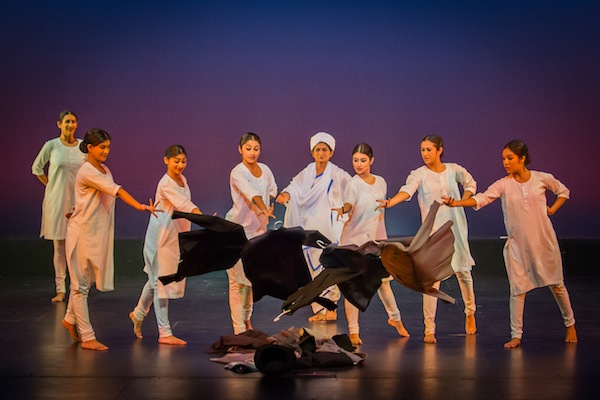
Abhinaya April 2013 update: Female dancer in male roles
By Mythili Kumar, Abhinaya Dance Company
At the conclusion of our ‘Gandhi” performance in Fremont on March 31st, Abhinaya dancers proceeded to meet the appreciative audience in the theater lobby. One woman brought her two children who were excited to meet Gandhi, and they were somewhat disappointed that it was me as I was playing the title role. Instead of a man, they encountered a female in her fifties dressed in the dhoti, a white linen cloth wound around the waist which is the typical traditional attire for an Indian male. Unlike in western dance shows, this custom of females playing the male roles in a ‘dance-drama’ or story production is very common in Indian dance performances. In ‘Gandhi’, the all-female cast of dancers portrayed the roles of little Gandhi and his friends, kings, landlords, farmers, and British guards adding small accessories like coats, hats, turbans, or sashes to denote the characters. In fact in the solo style of Bharatanayam, the dancer is in a generic dress of a young maiden and portrays all the characters in a story without changing her costume. This is done through the use of different gestures, stances and gaits appropriate to the character, and by using ‘tandava’ (vigorous) movements for the males versus lasya (graceful) movements for the female. So a trained dancer in a solo setting can portray characters ranging from a ferocious demon to a mischievous child. If trained male dancers were available they could more appropriately play all the male characters in a dance-drama. Despite the fact that the Supreme Dancer in Hindu mythology, Nataraja, is male, and that other classical dance styles Kathakali and Kuchipudi were performed solely by males until the 20th century, sadly there is less interest among males in pursuing dancing. In any dance school whether Indian or western, we will find a predominant female population. In fact Abhinaya has graduated only one male dancer from among the 120 students who have performed their solo debut or arangetram. In addition, there is the problem of compatibility of height, style of dance, and training. Our principal dancer Rasika Kumar is 5’11” in height and finding an Indian male dancer to match her is well-nigh impossible as the average height of Indian males is only 5’8”!
The past decade, however, has seen an upsurge of male dancers entering the Bharatanatyam scene. The famous institution of fine arts, KALAKSHETRA in Chennai, India has been graduating male dancers in significant numbers over the past years and many are performing as guest artists in other company story productions. I am constantly on the lookout for excellently trained tall male dancers visiting or moving to the Bay Area. Until that happens, I do not foresee any change in this practice of females playing male roles in Abhinaya performances.
Recent Content
-
Artsarticle ·
-
Artsarticle ·
-
Artsarticle ·
